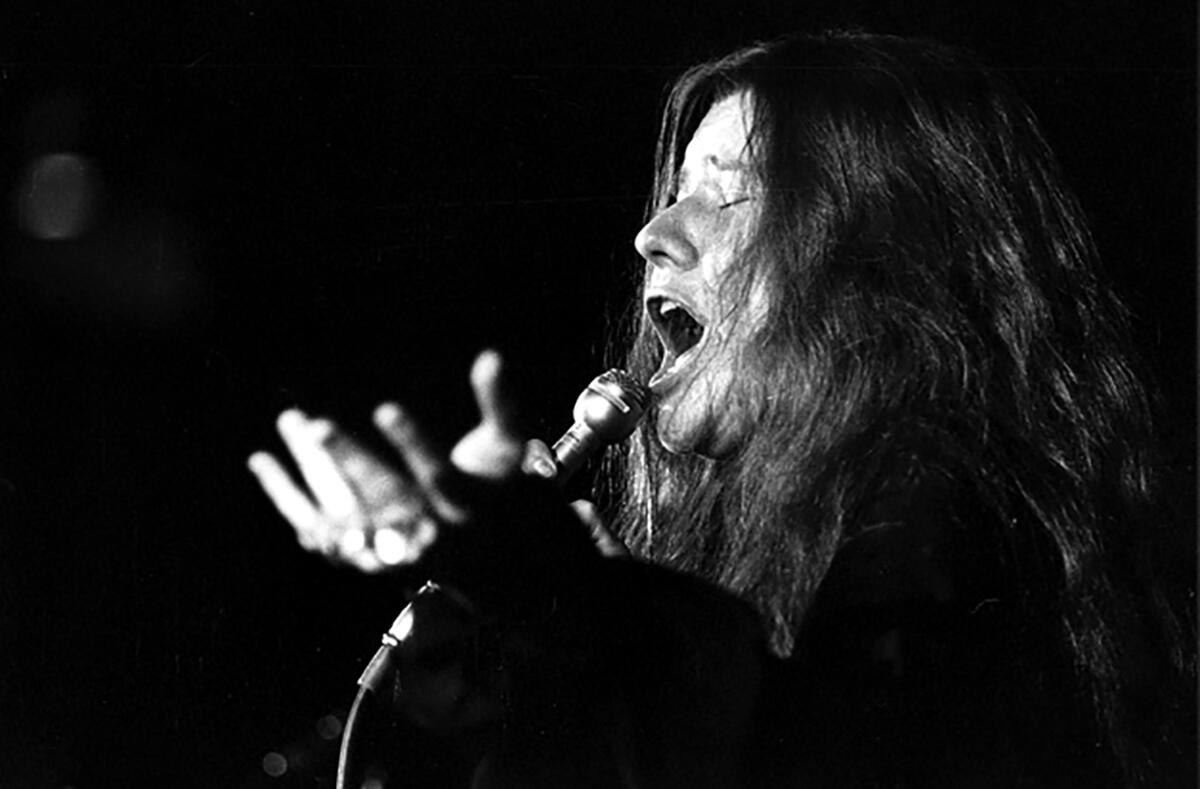Column: Janis Joplin died 50 years ago. Here’s why her loss still resonates today

- Share via
The hotel on the corner of Franklin and North Sycamore avenues in Hollywood is no longer known as the Landmark; now it’s the Highland Gardens Hotel. It’s got different owners and has had some superficial work done. But Room 105 is mostly unchanged.
I was a boy when Janis Joplin died in that room 50 years ago this week. She was found dead on the floor next to the bed. Thomas Noguchi, L.A.’s “coroner to the stars,” described for the press the alcohol in her bloodstream, the hypodermic found by the bedside and the packet of white powder in the trash.
The death was ruled an accident. A heroin overdose.
I’m not quite sure why I wanted to see the room, but apparently I’m not alone — people ask about it several times a week, according to the hotel’s current owner, even when there’s no special anniversary at hand. I guess seeing it adds an element of reality to what is otherwise just history. There’s a shrine of sorts in the room’s closet, the inner wall covered with scrawled notes to the late singer. Otherwise, it is just a room.
Janis Joplin was the “hippie queen of show business,” the biggest female star in the history of rock ‘n’ roll when she died, according to the Los Angeles Times. Her role models were Otis Redding and Bessie Smith, and she belted out a raw, raspy, exuberant blues that no one expected from a white girl from Port Arthur, Texas. She decked herself out in outlandish psychedelic beads, bangles and feathers, with oversized sunglasses tucked into unruly hair. On stage, she was all energy and intensity and sexuality, but there was vulnerability mixed in. The sweat flew from her face when she sang.
Joplin was only 27 when she was found in Room 105 on Oct. 4, 1970. “Right about there,” says the owner, pointing toward the corner.
That was just three weeks after guitarist Jimi Hendrix died in London and nine months before Jim Morrison of the Doors died in Paris. It was 10 months after a man was stabbed to death at the Altamont music festival and five months before the Weather Underground accidentally blew up a townhouse in Manhattan while making bombs.
But of course Joplin didn’t die because of the turbulent times or the zeitgeist or because the 1960s had given way to the 1970s; she died because she drank too much and did too many drugs and, for all her bravado, was deeply self-destructive.
In a dressing room interview at the Hollywood Bowl with critic Robert Hilburn in 1969, Joplin tried to sound nonchalant about death.
“Sure, I could take better care of myself,” she said. “I could eat nothing but organic foods, get eight hours of sleep every night, stop smoking. Things like that. Maybe it would add a couple of years to my life. But what the hell.”
Hilburn, a 29-year-old working for the L.A. Unified School District at the time of the interview, sold the piece to the Los Angeles Times and went on to a three-decade career as the paper’s rock critic. Joplin died a year later. What the hell, indeed.
Her own death was a theme Joplin repeatedly came back to. “Maybe I won’t last as long as other singers,” she said in another interview. “But I think you can destroy your now worrying about tomorrow.”
There was something so poignant in the contrast between her life-is-cheap attitude (symbolized by the trademark bottle of Southern Comfort she carried on stage) and her bookish good-girl interior. She so desperately wanted to please her parents. This came through in her letters home even as she was becoming a superstar. “I apologize for just being so plain bad in the family,” she wrote. “I realize that my shifting values don’t make me very reliable and I’m a disappointment, and, well, I’m just sorry.”
In the months before she died she paid for a tombstone to be built at the unmarked grave in Philadelphia of Bessie Smith. She went back to Port Arthur for her 10th reunion at the high school where she’d felt ostracized in her teens.
She went on “The Dick Cavett Show,” appearing with Gloria Swanson. She described herself as an “F. Scott Fitzgerald freak.”
She contained multitudes, obviously. But in her final days, she was back on the heroin that ultimately killed her.
Today so much time has passed that her contemporaries are beginning to die of natural causes.
And rock ‘n’ roll has changed.
Concert promoter Bill Graham held up Joplin — again to Hilburn, but 20 years later — to make a point about the commercialization of the industry. “Do you realize that if Woodstock took place now, Southern Comfort would pay her a million dollars for just holding that bottle?” he said.
Hilburn himself is reluctant to opine on the cultural significance of Joplin’s death.
“I am always wary of end-of-an-era statements,” he said recently. “It might be looked upon as the end of an era by you, but it’s very hard to single out any moment as the end of the ‘60s. If pressed, I would say the breakup of the Beatles or, oddly, Woodstock and the realization by record companies and the media that rock was big business. I wouldn’t personally put Janis’ death by itself on a short list of ‘end of the ‘60s’ incidents.”
For my part, I’ll stick with the opening lines of one of my favorite Joplin songs (written by Jerry Ragovoy and Mort Shuman). I advise you to watch it here.
“In this world, if you read the papers, darling
You know everybody’s fighting, ah, with each other.
You got no one you can count on babe
Not even your own brother.
So if someone comes along,
He gonna give you some love and affection.
I’d say get it while you can.
Honey get it while you can.”
I should’ve written those words in the Room 105 closet.
More to Read
A cure for the common opinion
Get thought-provoking perspectives with our weekly newsletter.
You may occasionally receive promotional content from the Los Angeles Times.











